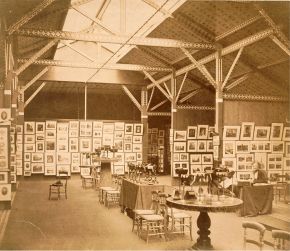
Charles Thurston Thompson, 'Exhibition of the Photographic Society of London and the Société française de photographie at the South Kensington Museum, 1858', 1858. Museum no. 2715-1913, © Victoria and Albert Museum, London
On 12 February 1858, Henry Cole, the founding director of the South Kensington Museum, recorded in his diary:
'Museum: Queen &c came to private view of the Photographic Socy, being the first exhibition in the Refreshment upper room'.
The exhibition was not only the first to take place in that part of the museum. It was in fact the first exhibition of photographs to be held in any museum. Consisting of 1009 photographs, it was organised by the Photographic Society of London and included approximately 250 contributions from its French counterpart, the Société française de photographie.
As the Museum's official photographer, Charles Thurston Thompson recorded the 1858 display with his camera, creating the earliest known photograph of a photographic exhibition. The view shows a densely-packed display of a wide range of subject matter, including portraits, landscapes, architectural views and reproductions of works of art, with even more photographs viewable through stereoscopes crammed onto tables in the middle of the room.
Today, the V&A (as the South Kensington Museum came to be called) holds numerous photographs shown in the 1858 exhibition. Three of these works are visible in Thompson's view: William Lake Price's Don Quixote in his Study, Roger Fenton's Head of Homer and Thompson's own Oak, Albury Park, Surrey. Other photographs in the V&A Collection that were also shown at the time but do not appear in the Thompson image include works by such major 19th-century photographers as Gustave Le Gray, Edouard Baldus and Francis Frith.
The images below were all featured in the 1858 exhibition.
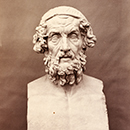
Roger Fenton, 'Head of Homer'
Roger Fenton (1819-69)
'Head of Homer'
About 1855
Salted paper print
Museum no. 40:810
© Victoria and Albert Museum, LondonFenton was one of the most important British photographers of the 19th century. A practicing barrister, he studied painting before taking up photography in the early 1850s. In 1852 he went to Russia to photograph Kiev, St Petersburg and Moscow, and was later the official photographer of the Crimean War. In 1853 he was part of a group that founded the London Photographic Society. He also photographed the royal family, made sumptuous still lifes and landscapes, and turned his camera to English gothic architecture.
Also in 1853 Fenton was commissioned by the British Museum to document a range of the objects in its collection, including its sculpture holdings. Similar to the way in which Charles Thurston Thompson acted as official photographer to the V&A, Fenton was in service at the British Museum. The efforts of these early photographers enabled the institutions with which they were affiliated to better catalogue their collections and to share information on them. After a spectacular ten-year career, Fenton gave up photography and returned to law in 1862.
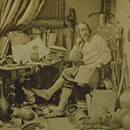
William Lake Price, 'Don Quixote in his Study'
William Lake Price (1810-96)
'Don Quixote in his Study'
1855
Albumen print
Museum no. 3-1976
© Victoria and Albert Museum, LondonApproaching photography as high art, Lake Price used it not simply to record reality, but to depict imagined scenes. His most characteristic photographs are elaborately staged scenes from history or literature. For example, here Don Quixote is seen in his study, surrounded by heaps of antiquities.
In 1858 Lake Price published A Manual of Photographic Manipulation, Treating of the Practice of the Art, and its Various Applications to Nature, which was the first book to instruct its readers not only on the technical aspects of photography but also on such aesthetic questions as composition and lighting. He was an active contributor to publications on the medium of photography until the late 1880s.
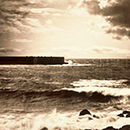
Gustave Le Gray, 'The Great Wave'
Gustave Le Gray (1820-84)
'The Great Wave, Sète'
1856
Albumen print
Museum no. 68:004
© Victoria and Albert Museum, LondonThe exquisite tonal quality, impressive scale and innovative exposure and printing methods of Le Gray's series of seascapes set high technical standards. They also elevated the evocative and poetic capacity of the medium of photography. Le Gray took this photograph, the most dramatic of these images, on the Mediterranean coast near Montpellier.
At the horizon, the clouds are cut off where they meet the sea. This indicates the join between the two separate negatives that Le Gray used to make this image. He would often use a different sky to complement his sea exposures. This combination of two negatives allowed the artist to achieve tonal balance between sea and sky on the final print. It gives a more truthful sense of how the eye, rather than the camera, perceives nature.
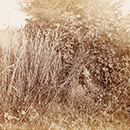
Henry Taylor, 'Corner of a Wheat Field'
Henry Taylor (1800-86)
'Corner of a Wheat Field'
About 1858
Salted paper print
Museum no. 36:593
© Victoria and Albert Museum, LondonTaylor exhibited numerous photographs at the Photographic Society of London's annual displays from 1855 to 1859. This image is a closely-cropped view of a field of wheat. As seen elsewhere in the 1858 exhibition of photographs held at the South Kensington Museum, detailed studies of this kind were commonly produced and displayed, and Taylor was well known for his plant studies and landscapes. The artist published his professional memoirs at the end of the 19th century.
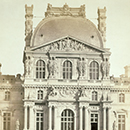
Edouard Baldus, 'Pavillon Richelieu'
Edouard Baldus (1813-89)
'Pavillon Richelieu, Louvre'
1856-7
Salted paper print
Museum no. 56:314
© Victoria and Albert Museum, LondonBaldus was among a group of photographers selected in 1851 by the French government's Historic Monuments Commission to document the nation's historic and contemporary architectural achievements. He used 'mammoth plate' glass negatives (approximately 77 x 55 cm) to photograph the recently completed buildings that were additions to the Louvre Museum. The results show superb clarity of detail while conveying the imposing scale and grandeur of the buildings. Baldus's images are both powerful records of French landmarks and expressions of national pride. He was one of the most prolific of French photographers of the 1850s and 1860s.
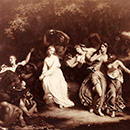
Caldesi and Montecchi, 'Una and the Wood Nymphs after W. E. Frost'
Caldesi and Montecchi (active 1850s)
'Una and the Wood Nymphs after W. E. Frost, A. R. A.'
1857-8
Albumen print
Museum no. 34:436
© Victoria and Albert Museum, LondonCaldesi and Montecchi were highly sought-after photographers during the 1850s, particularly for their skills in portraiture. The partners were summoned to capture a series of images of the royal children, for example. They were also well known for their reproductions of works of art. The photographs they included in the 1858 exhibition at the South Kensington Museum were praised by the Athenaeum (20 February 1858): 'The copies of paintings made by Messrs. Caldessi and Montecchi are … minute, careful and successful,-truer, softer, and surer than engravings, and expressing more of the colour and sentiment of the picture.'
The image Una and the Wood Nymphs depicts an allegory from Edmund Spencer's poem The Faerie Queene, first published in 1590. Although the V&A does not hold this particular painting by William Edward Frost (1810-77), several of his other oils form part of the Museum's Collection. Frost was best known for his success in painting the female nude. He was elected an associate member of the Royal Academy in 1846 and full member in 1870.
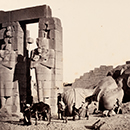
Francis Frith, 'The Rameseum of El-Kurneh
Francis Frith (1822-98)
'The Rameseum of El-Kurneh, Thebes'
About 1858
Albumen print
Museum no. Ph.5-1983
© Victoria and Albert Museum, LondonThroughout the 1850s and 1860s photographs of historical and topographical sights were highly desirable and Frith was one of the most successful commercial photographers to cater to this demand. His pioneering photographic expeditions to the Near East proved very popular. The detail afforded by wet collodian negatives, as used for this image, produced prints that British publishers readily marketed. This photograph captures the monumentality of Egyptian landscape and architecture as well as the dramatic play of light on sand and stone.
The Art Journal (1 April 1858) published extensive commentary on Frith's contributions to the 1858 exhibition: 'The real value of photography is, however, most strikingly shown in the productions of F. Frith, jun. His subjects in Palestine and Egypt impress us with a consciousness of truth and power which no other Art-production could produce. The sands of the desert have for centuries been grinding those gigantic columns and colossal statues; and there, before us, is the abraded stone, every mark being preserved to tell how slowly, but yet how surely, the dust of the earth is overcoming the greatest works of man. All those photographs by Mr. F. Frith should be very carefully studied.'
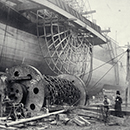
Robert Howlett, 'The Great Eastern'
Robert Howlett (1830-58)
'The Great Eastern'
1857
Albumen print
Museum no. Ph.259-1979
© Victoria and Albert Museum, LondonHowlett produced portraits of Crimean War heroes, genre scenes and landscapes. His major work, however, was to document the construction of the massive steamship the Great Eastern, known early on as SS Leviathan. The images he took as part of this series were translated into engravings for The Illustrated Times in 1858. They reflected and stimulated the widespread interest in this feat of engineering. When the Great Eastern was launched she was the largest ship in the world. She became a symbol of the greatness of the British Empire but she was in fact a commercial failure and was scrapped in 1888. Howlett also produced the well-known portrait of the Great Eastern's creator and engineer, Isambard Kingdom Brunel, standing in front of the ship's chains, which is perhaps one of the first examples of environmental portraiture.
The 1858 exhibition
The Photographic Society (now called the Royal Photographic Society) had been holding annual exhibitions since 1854 but the 1858 display was the first to be hosted by a museum. Despite the novelty of the location and many favourable reviews, 'There are many singularly beautiful pictures, upon which we gaze and gaze until we find ourselves transported in thought to the scenes so faithfully represented,' exclaimed The Art Journal (1 April 1858), attendance was low, and the exhibition was relocated to a more central venue near Piccadilly.
The Photographic Society exhibitions featured many genres of photography that are still common, such as portraits, landscapes and still-lifes. Also included were photographs of paintings and negatives, which today would not normally be exhibited in an art museum but which reflected the interest at the time in the multiple uses to which the new medium of photography could be put.
Critics in the mid 19th century were engaged in a debate about the nature of photography as a science or an art. One writer for the Athenaeum, however, found the two categories of work gracefully melded together in the 1858 exhibition:
'Altogether, whether for light and shade, breadth and dignity, atmosphere and detail, this Exhibition is an advance on the efforts of last year. The artists go on boldly, and are not afraid to be chemists; the chemists gain courage, and long to be artists' (Athenaeum, 20 February 1858).
Photographs from the 1858 exhibition in the collection
The Thompson view of the 1858 exhibition is emblematic of the V&A's long history of collecting and exhibiting photographs. The Museum began collecting photographs in 1852. Although it did not acquire any work directly from the exhibition, a number of photographs shown in 1858 subsequently entered the collection.
In 2009, V&A curators identified over 40 photographs now in the V&A collection that were included in the 1858 exhibition. (Since photographers often produce multiple prints of the same image, these photographs are not necessarily the exact prints displayed.) In addition to the works pictured above, they include other examples from Robert Howlett's series on the launching of the Great Eastern, further travel views by Francis Frith and tree studies by Charles Thurston Thompson, a still-life by Francis Bedford and an architectural view by Henry Holden.
The range of holdings that can be linked to the 1858 exhibition reflects the depths of the V&A's collection of 19th-century photography. The V&A not only held the first museum-based exhibition of photographs but it continues to acquire and exhibit historical and contemporary photographs today.
International Training Course
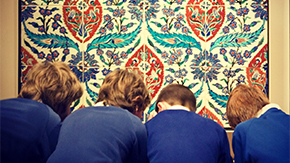
The Victoria and Albert Museum welcomes applications for ‘Creating Innovative Learning Programmes’, its new one week intensive course. This is a unique training opportunity for museum professionals from overseas who are interested in attracting and programming for a range of museum audiences.
Find out more






